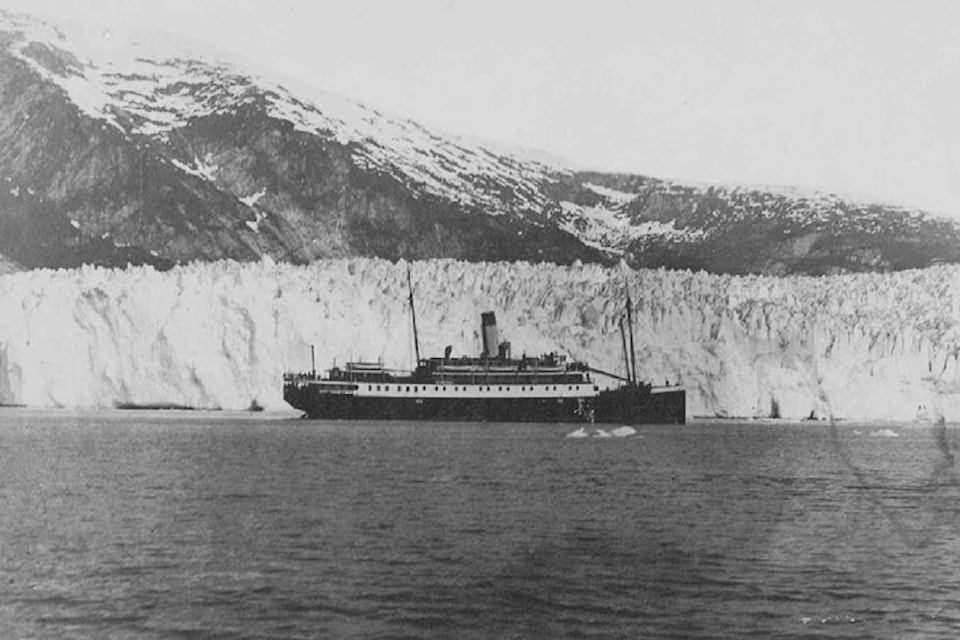A century after what’s considered to be B.C.’s worst marine tragedy, even though it occurred in Alaskan waters, the Maritime Museum of B.C. is presenting a special exhibit marking this historic tragedy.
“Just time to say goodbye. We are foundering.”
The pathetic farewell of 343 persons was flashed through the night of Oct. 24, 1918. Then silence.
Anxiously, the rescue boats bucking gale-swept Lynn Canal listened for more. But the S.S. Princess Sophia was never heard from again.
With morning came calm, but only a mast tip marked the 2,300-ton pocket liner’s grave by Vanderbilt Reef. There was not one survivor.
Winter had struck the west coast early and hard in 1918. Driven off course during a blinding snowstorm, the Sophia grounded on Vanderbilt Reef early on the morning of Oct. 24 and stuck fast. Capt. F.L. Locke, a veteran of 27 years’ service with Canadian Pacific, immediately radioed particulars to his company, the B.C. Coast Service.
Capt. Locke didn’t think his ship was in danger. Both he and senior company officials believed that the Sophia would float off the reef on the next high tide, expected that afternoon. The salvage steamer Tees, just returned from rescuing the CPR steamer Princess Adelaide from reefs at Georgina Point, prepared for immediate departure from Victoria.
Aboard the Sophia was one of the largest lists of passengers handled that year. Most were from the interior of Alaska, having reached Whitehorse on the last boats before river navigation closed for the winter. They were southbound to the “outside” to enjoy the season in a more pleasant climate. Sharing Capt. Locke’s confidence that the Sophia would float free, they whiled away the time calmly.
Both Victoria newspapers, the Times and the Colonist, gave the story prominent and thorough coverage, providing the latest details to a news-hungry city all too familiar with marine disasters. Victorians followed the news reports closely, speculated among themselves and…waited.
CPR news releases were encouraging: “The waters of Lynn Canal [where, many would recall, the passenger ship Islander had gone down with great loss of life after striking an iceberg, 17 years before] are well protected and no loss of life is feared…”
When Sophia failed to float off on Thursday’s afternoon tide, officials insisted that the ship was in no immediate danger, that the Tees would proceed to the scene, that the Princess Alice had been dispatched to perform a transfer of the passengers, and that “If the weather holds fair, there should be no difficulty in getting the Sophia afloat on the tides which occur early next month.”
Press stories unwittingly carried the first hint of tragedy when they reported that “a fresh northerly breeze” was blowing down the canal, making it impossible to effect a transfer of passengers to any of the vessels that were by this time standing by.
These vessels were the American ships Cedar and Peterson, the auxiliary schooner King & Wing, and many smaller craft, most of them fishing vessels.
CPR officials remained optimistic although they admitted their concern about their disrupted passenger services which required that they juggle schedules and steamers in an attempt to keep all routes operating. However, while admitting publicly that they were having increasing difficulty making contact with the Sophia, they reassured Victorians that all would work out well; should the situation deteriorate the small fleet of vessels on the scene would take care of all those on board the Sophia.
The announcement of Sophia’s sinking hit Victoria like an earthquake. People weren’t just shocked, they were numbed. A brief wireless message had been relayed to Victoria from Juneau, stating that, some time during the night, the ship that had made its home port in Victoria since arriving from a Scottish shipbuilder six years before, had sunk.
In some quarters the news was received with disbelief. Capt. J.W. Troup, manager of the B.C. Coast Steamship Service, said, “It is hardly conceivable. I cannot believe it.” He desperately tried to get official confirmation or denial from Alaska. Because the telegraphic cable to Skagway was out of commission, the only means of communication was by wireless, then in its infancy and never to good at best of times.
Upon hearing the report of her sinking, many Victorians held the hope that those aboard had been picked up by the many rescue craft standing by.
Except for the initial wireless report that Sophia was gone, Victorians knew nothing. They impatiently waited for Princess Alice to reach the scene. With her powerful transmitter she’d be able to report the situation.
(To be continued)
The Princess Sophia centenary exhibition at the Martime Museum of B.C. continues until March 11.
